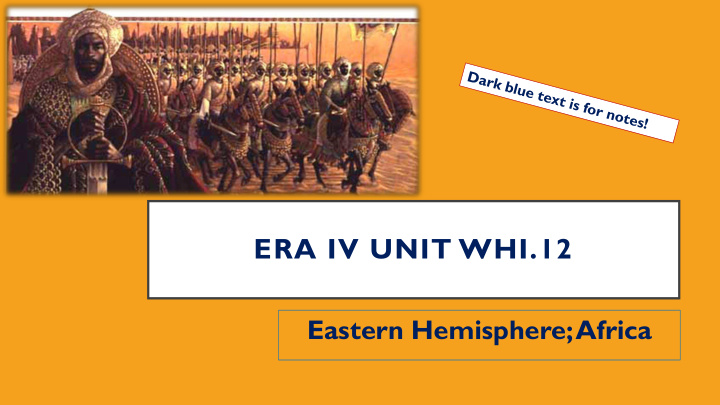



ERA IV UNIT WHI.12 Eastern Hemisphere; Africa
EASTERN HEMISPHERE; AFRICA 1000- 1500CE
AFRICA’S HISTORY LOST… • Muslim Arabs enslaved Africans after a battle. • They were transported, with Asians and Europeans, across the Red Sea, Indian Ocean, and the Sahara Desert. • From the late 15th century, Europeans joined the slave trade, with the Portuguese initially acquiring slaves through trade and later by force.
AFRICA TODAY:
AFRICA • WHI.12 The student will apply social science skills to understand the civilizations and empires of Africa, with emphasis on the African kingdoms of Axum and Zimbabwe and the West African civilizations of Ghana, Mali, and Songhai, by • a) locating early civilizations and kingdoms in time and place and describing major geographic features; • b) explaining the development of social, political, economic, religious, and cultural patterns in each region; and
I. WEST AFRICA; GHANA, MALI, SONGHAI: A. Location- • Niger River and the Sahara B. Trade- • gold and salt C. City- • Timbuktu • center of trade and learning D. Religion- • animism and Islam
GHANA
GHANA
GHANA
GHANA
GHANA • 790- 1076 • First of several west African empires to dominate the gold and ivory trade • Conquered and split up by Muslim invaders from northern Africa
WEST AFRICAN TRADE: • The various kingdoms in West Africa made very good trading partners. The north had salt. The south had gold. • Ghana was in the middle. Ghana handled the trades. • Trades were even, ounce for ounce - an ounce of gold for an ounce of salt. • Both sides - north and south - paid Ghana a tribute to handle the trades.
GHANA GETS RICH… • Although Ghana never owned gold and salt mines, they controlled the trade between the kingdoms to the north and the kingdoms to the south. • With the arrival of camel trains, the caravans, the Kingdom of Ghana expanded their control to include trade with the foreigners. They traded gold for spices and other luxury goods as well as salt.
MALI
TIMBUKTU
MALI • 1230- c. 1400’s • Replaced Ghana • Used military force to expand territory • Began selling war captives to the Arabs as slaves • Adopted Islam as its religion
E. MANSA MUSA 1. Great King from Mali 2. famous pilgrimage to Mecca (1324-1325) • Caravan included: • 500 slaves bearing golden staffs • 100 camels, each loaded with 300 pounds of gold • 12,000 slaves • Effected economies wherever they passed • It took Cairo, Egypt 12 years to recover!
QUR’AN SCHOOL IN MALI
SONGHAI
SONGHAI • Early 1400’s to late 1500’s • Replaced Mali • Emperor Sunni Ali adopted strict Shari’ah Law • Declined due to weak leadership and slave trade
SLAVERY IN SUB-SAHARAN AFRICA
SONGHAI
SONGHAI
AXUM
AXUM
II. AXUM • A. Location- • Ethiopian Highlands and the Nile River
AXUM • Between the third and sixth century A.D. (C.E.) • Became a great market in northeastern Africa • Merchants traded with civilizations beyond the Nile River • During the fourth century A.D. (C.E .) • B. Became a Christian kingdom • Became politically and economically linked to Roman Egypt
AXUM
AXUM
QUEEN OF SHEBA • Known in biblical, Islamic and Ethiopian tradition • Shown here on her way to visit King Solomon in Jerusalem • The illustration is from the early 20th century by French-born English illustrator Edmund Dulac.
QUEEN OF SHEBA • Ethiopian (Aksum) legendary wife of Solomon • In the biblical Book of Kings (I Kings 10), the Queen of Sheba visits King Solomon at his court in Jerusalem • Hoping to impress him with her wealth, she arrives with a camel-train laden with spices, gold, and jewels • She is overwhelmed by the splendor of Solomon’s state, however, attributing this, and his people’s good fortune in being governed by such a king, to the Hebrew god, Yahweh
ZIMBABWE
ZIMBABWE
ZIMBABWE
III. ZIMBABWE • A. Location- • proximity to Zambezi and Limpopo rivers and the Indian Ocean coast • B. City- • “Great Zimbabwe” as capital • C. Prosperous empire
ZIMBABWE
ZIMBABWE • D. Utilized Indian Ocean trade routes to connect with Asia •
ZIMBABWE
ZIMBABWE
ZIMBABWE • Prosperous empire • Cattle herding • Descendants of Bantu people • Zimbabwe collapsed due to the slave trade
AFRICA
POINT OF NO RETURN
AFRICA • WHI.12 The student will apply social science skills to understand the civilizations and empires of Africa, with emphasis on the African kingdoms of Axum and Zimbabwe and the West African civilizations of Ghana, Mali, and Songhai, by • c) evaluating and explaining the European interactions with these societies, with emphasis on trading and economic interdependence.
IV. EUROPEAN INTERACTIONS WITH AFRICA A. God, Glory, and Gold! • Support for diffusion of Christianity (God) • Political and economic competition between European empires (Glory) • Demand for gold, spices, and natural resources in Europe (Gold)
EUROPEAN INTERACTIONS WITH AFRICA B. Age of Exploration Innovations of European and Islamic origins in navigational arts 1. New technologies for sailing Pioneering role of Prince Henry the Navigator 2. Prince Henry the Navigator promoted explorers (he had a school) European trading posts were established along the coast of Africa 3. Europe begins to take hold of Africa
EUROPEAN INTERACTIONS WITH AFRICA Prince Henry the Navigator
THE END
Recommend
More recommend